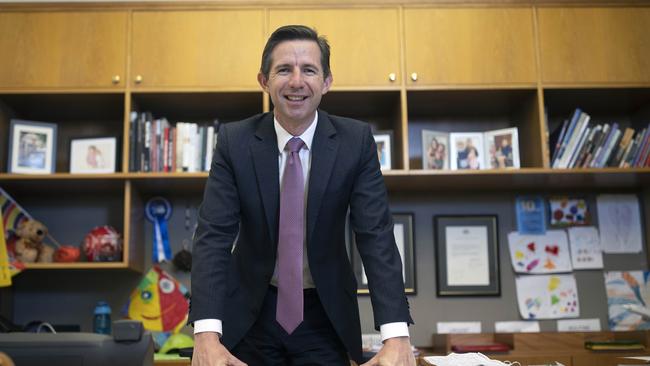With surpluses off the agenda, let’s say farewell to financial discipline

Not that the Reserve Bank is directly monetising government debt, although it is likely to greatly expand indirect monetising next month, but with at least 10 years of deficits ahead according to Treasury, with no prospect of a surplus, fiscal discipline will have to be reinvented.
Deficits no longer matter politically, just as they don’t matter economically, and aiming for a surplus can’t be the reason for the Treasurer saying no to mendicant ministers.
A decade of deficits is not bad in itself. As MMT advocate Stephanie Kelton wrote in her book The Deficit Myth, “fiscal deficits … are neither good nor bad. What matters is not whether the government’s budget is in surplus or deficit, but whether the government is using its budget to achieve good or bad outcomes for the rest of the economy.”
Over the past 10 years, the Australian government has racked up an unbroken succession of deficits totalling $429.5bn. In the next 10 years, according to Treasury forecasts, there will be another $1 trillion worth of them, taking government debt to $1.8 trillion.
Whether that ends up being good or bad for the economy depends on what is done with the money, but aside from the numbers a very important change has occurred: over the past decade, governments have at least been trying to get back to surplus, albeit unsuccessfully, so there’s been some discipline imposed on spending. Now that a budget surplus is neither possible nor forecast, trying for it is no longer credible. Spending discipline could go out the window.
Early signs
There are already signs of that in this week’s budget.
The two big programs that dominated the marketing and the commentary are the $74bn JobMaker Plan and the $25bn COVID-19 Response Package.
What hasn’t got a lot of attention is the $15.8bn in other spending measures over four years. It would be an even $16bn if the government hadn’t budgeted to save $200m by cutting the humanitarian refugee program, so that’s $4bn a year of locked-in extra spending across dozens of departments and agencies.
And unlike the two big-ticket programs, that spending is not temporary, and almost all of it involves hiring people. The average public service wage is $84,400, so that’s about 45,000 more commonwealth public servants. The 690,000 or so jobs that are supposed to come from the JobMaker Plan is a Treasury guess and Treasurer hope, but those 45,000 extra jobs with the government are locked in; the agencies that are being showered with the money will waste no time hiring the staff and expanding their empires.
Moreover, there are dozens of random things that have been labelled “JobMaker Plan” that probably would have happened anyway but were thrown into the soup to thicken it, things like “investment in new energy technologies”, money for the CSIRO, “women’s economic security”, Treasury’s digital business plan, and securing liquid fuel stocks.
In all, there are 108 items in the budget branded “JobMaker Plan”, and 69 labelled “COVID-19 Response Package”. JobMaker is not really a plan, by the way — there is no government body running it, it’s just a budget marketing label, with the money scattered through government departments, to be administered by each of them. Nobody will account for the spending as a package, and a lot of the money will go towards hiring public servants, not out to businesses to hire private sector workers.
Nothing necessarily wrong with any of that: these are real jobs that will support a lot of families in difficult times.
But reading the detail of the budget measures you get the strong sense that the pandemic has allowed Australia’s bureaucratic machinery to breathe out for the first time in a decade.
“Yes” clearly replaced “No” when departmental officials fronted Treasury and Finance with their budget requests this year, unlike every other year since the GFC, which was the last time the constraints came off.
In for a penny...
That’s hardly surprising. As soon as the pandemic hit it was obvious government spending had to increase massively to save the economy, and once it was clear the deficit was going over $100bn in 2020-21, there wasn’t much point holding back. In for a penny, in for a pound and all that — in fact budgetary restraint would have been out of place.
So how is Finance Minister Simon Birmingham going to start saying no again when there can be no credible aspiration to get the budget back into surplus? Returning to surplus has been a guiding political imperative during seven years of Coalition rule — along with resisting anything that looks remotely like emissions trading — and has been shared by everyone in the party room and cabinet as a fundamental principle of conservative government. Both of those foundations of Coalition philosophy are crumbling.
Even on the best-case scenario, based on forecasts that are barely credible, Treasury is predicting deficits for longer than most politicians on both sides of the aisle expect to be in parliament.
The valid concern with MMT is that if politicians believe government spending can be funded by printing money, they will recognise no restraint. But what if the restraint goes anyway?
Alan Kohler is the editor in chief of Eureka Report







Everybody can stop worrying about the so-called snake oil mumbo jumbo of modern monetary theory — it’s already here. MMT is effectively with us, like it or not.